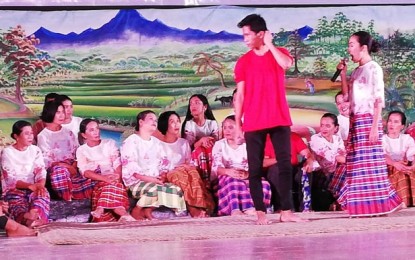
IP RIGHTS. Members of the Panay-Bukidnon IP community from Barangay Panuran, Lambunao town perform a cultural show. NCIP regional director Ana Burgos said on Thursday (Oct. 17, 2019) the IPs in Lambunao is now qualified to have their mandatory representative in the council because of the presence of an ancestral domain area. (PNA photo by Perla G. Lena)
ILOILO CITY -- The National Commission on Indigenous Peoples (NCIP) on Thursday reminded indigenous peoples (IPs) of their mandatory representation in the legislative council as among their rights.
In an interview on Thursday, Ana Burgos, NCIP regional director for Western and Central Visayas, said all ancestral domain areas are qualified to have an IP mandatory representative (IPMR), either in the barangay council or the Sangguniang Bayan (SB).
They will be serving for two terms and enjoy the privilege of a regular SB member. “He/she will be the voice of the community. The IPMR should stand for the IPs in his/her area,” she said.
Since they are not elected, they have to go through a selection process in their community.
In Iloilo, only an IP community in Janiuay has an IPMR.
However, Burgos said the IP community in Lambunao is already qualified to have an IPMR because it has an ancestral domain area based in Barangay Jayobo.
“In Lambunao it is automatic because they have an existing ancestral domain. If they are interested, they can already process it,” she said.
Burgos said what is needed is to conduct an information education campaign (IEC) so the local government unit will understand that IP representation is mandated under Republic Act 8371, or the IP Rights Act (IPRA) of 1997.
She added that local officials have to be informed because the inclusion of the IPMR needs allocation.
Lambunao Tourism Officer Jennifer Osorio, in a previous interview, said seven of the 73 barangays of Lambunao were certified as 100 percent IP barangays by the NCIP and three more are in the process of applying for the certification.
The IP certified barangays are Panuran, Cabatangan, Walang, Caguisanan, Jayobo, Bagongbong, and Agsirab while those still applying are Caninguan, Sagcup, and Pughanan.
Those certified IP barangays have a directory of their members and enjoy the privilege afforded by the government to their sector.
Lambunao Vice Mayor Arvin Losaria, in a previous interview, said the LGU is supportive of the IPs. He underscored the importance of keeping their traditions alive for the “younger generations to know and appreciate the culture of our elders”.
“This year we will pass an ordinance to ensure sustainable support for the IP communities. IPs will be given priority in terms of support so that our living tradition will spread to the younger generations in Lambunao,” said Losaria, who also sits as chair of the Sangguniang Bayan committee on education and culture.
He added that having seven barangays as IP-certified “definitely speak of the municipality of Lambunao as an IP community”.
Burgos said there are more than 200,000 IP in Central and Western Visayas. Western Visayas has the Ati and Bukidnon IP with various sub-groups.
Iloilo has more than 70,000 IPs; Antique, around 30,000; Bacolod City, around 40,000 and Negros Oriental, more than 30,000.
As part of the National IP Month celebration this October, the NCIP will install one IPMR in Kabankalan City in Negros Occidental on Oct 22; and provincial IP celebration in Antique on Oct 25 that will be highlighted by the release of a PHP1 million one-time educational grant facilitated by Antique Representative Loren Legarda to 200 IP students enrolled in senior high school and college. (PNA)
